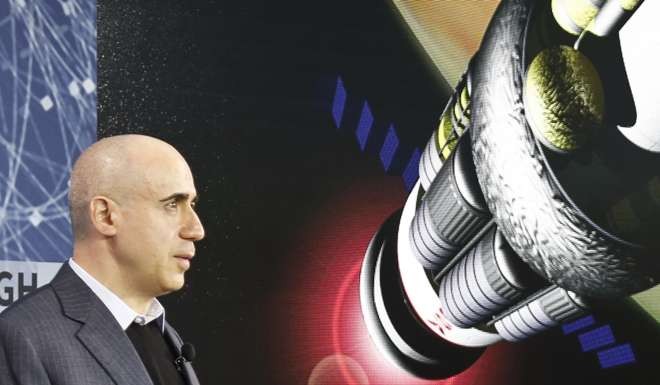China’s giant FAST radio telescope to join hunt for extraterrestrial intelligence
But busy schedule could delay attempt to probe flickering star

The world’s largest radio telescope, in southwestern Guizhou (貴州) province, is joining an international search for extraterrestrial intelligence focused on a strange, flickering star that has sparked unprecedented curiosity in recent months.
Andrew Siemion, director of the SETI (search for extraterrestrial intelligence) Research Centre at the University of California, Berkeley, said in October that the centre had entered into a partnership with the FAST radio telescope in the hunt for evidence of advanced civilisation in space.
The 1.2b yuan (HK$1.37 billion) FAST – short for five-hundred-metre aperture spherical telescope – has a dish bigger than 30 soccer fields and a diameter almost 200 metres greater than the world’s second-biggest radio telescope, operated by the United States at Arecibo in Puerto Rico.
The Berkeley centre’s Breakthrough Listen project, a US$100 million initiative founded last year by internet investor Yuri Milner to conduct a 10-year search for intelligent life in space, is leading the hunt.
“Breakthrough Listen recently entered into a partnership with FAST and the National Astronomical Observatory of China,” which built and operates the telescope, said Siemion, who is also a co-director of Breakthrough Listen.
In late October, Breakthrough Listen began targeting the flickering star – unofficially known as Tabby’s star – which is about 1,500 light years from earth in the constellation Cygnus, using the 100-metre-wide Green Bank Telescope in West Virginia, US.
Officially called KIC 8462852, it was first flagged in September 2015 by American astronomer Tabetha Boyajian, then a post-doctoral researcher at Yale University and now an assistant professor at Louisiana State University.
Observations by Nasa’s Kepler space telescope showed the star dimming considerably and irregularly for days at a time – unlike the dimming of other stars caused by planets or comets.
But the pattern was a good match for the blocking that would be caused by a Dyson structure, a massive array of solar collectors that could be built by a highly developed civilisation to surround a star to capture energy, first proposed by American physicist Freeman Dyson in 1960.
And that drew the attention of telescopes around the world.
“Everyone, every SETI programme telescope, I mean every astronomer that has any kind of telescope in any wavelength that can see Tabby’s star has looked at it,” Siemion said. “It’s been looked at with Hubble [Space Telescope], it’s been looked at with Keck [Observatory in Hawaii], it’s been looked at in the infrared and radio and high-energy [spectrums] and every possible thing you can imagine, including a whole range of SETI experiments. Nothing has been found.”

But FAST, which began operating in September, offers new hope.
“The FAST telescope will be absolutely incredible for conducting extremely sensitive searches of Tabby’s star for evidence of technologically produced radio emissions,” Siemion said. “We are very excited to work with our colleagues in China on conducting SETI observations with FAST, including of Tabby’s star. Within its frequency range, FAST is the most sensitive telescope in the world capable of conducting SETI observations of Tabby’s star, and will be able to detect the weakest signals.”
A researcher in Beijing involved in the joint effort said they hoped to use FAST to search for aliens as soon as possible, but it was extremely difficult to find a free time slot in the telescope’s busy schedule.
“The schedule is full. So full, in fact, I don’t think we can do anything within two years,” said the researcher, who declined to be named.
Mainstream astronomical research topics such as pulsars were given priority on FAST’s schedule, the researcher said. Looking for aliens was not regarded as an urgent task because all previous efforts had failed, and it was relatively difficult to get a SETI paper published in a top research journal.
Even buying a few hours of time on FAST would be prohibitively expensive. While SETI observation overseas was funded by many private organisations, in China the funding for astronomical observation came almost exclusively from the government, the researcher added, which also limited astronomers’ efforts to search for extraterrestrial intelligence.

Beijing Planetarium director Zhu Jin said he had confirmed with the FAST team that Tabby’s star fell well within FAST’s detection zone.
The FAST telescope had a very wide viewing angle, and its reflective panels were individually steerable, allowing it to focus on a specific spot in the universe to collect the most delicate signals, he said.
“Looking at Tabby’s star on FAST will be a very easy thing to do,” Zhu said. “When the telescope was proposed, SETI was listed as a major goal. I don’t think we can turn a blind eye to Tabby’s star.”
Peking University astronomer Professor Zhuang Huawei, who is also deputy director of the Beijing Astronomical Association, said the biggest challenge to SETI research was the lack of scientific tools to interpret the signals that were received.
“Even if you pick up an interesting signal, there is no way to confirm that it was produced by an intelligent species,” Zhuang said. “Most of the weird things we see in space were caused by nature.”